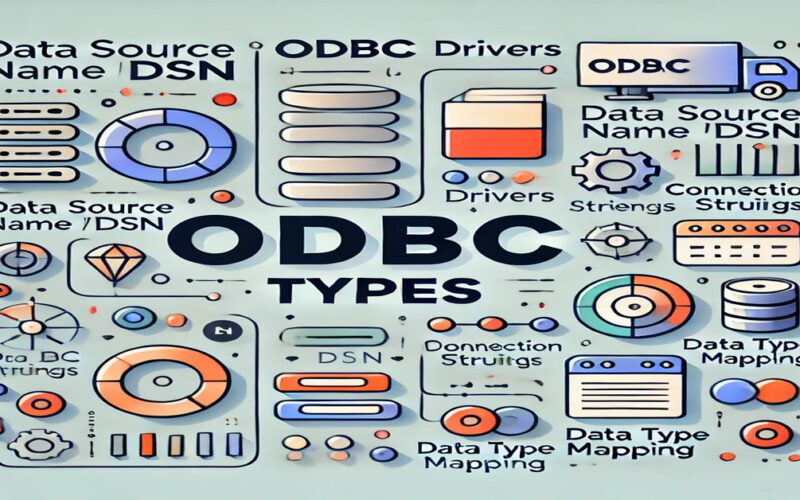Summary: This article provides a comprehensive overview of ODBC types, explaining their significance in database connectivity. It covers various ODBC driver types, including native, generic, and third-party drivers. Understanding these types helps developers choose the right driver for their applications, ensuring optimal performance and compatibility with different database systems.
Introduction
Open Database Connectivity (ODBC) is a standard API that allows applications to communicate with various Database Management Systems (DBMS).
It provides a universal data access method, enabling developers to write applications that can interact with different databases without needing to know the specifics of each system. This flexibility makes ODBC a popular choice for applications that require database access.
In this blog, we will explore ODBC in detail, including its definition, types of ODBC drivers, how to choose the right driver, setup procedures, troubleshooting common issues, and more. By the end of this article, you’ll have a comprehensive understanding of ODBC types and their importance in database connectivity.
Key Takeaways
- ODBC enables universal data access across multiple database systems.
- Native drivers offer optimised performance for specific Database Management Systems.
- Generic drivers provide flexibility but may lack advanced features.
- Choosing the right ODBC driver enhances application performance and reliability.
- Understanding driver types is crucial for effective database integration strategies.
What is ODBC?
ODBC stands for Open Database Connectivity. It is an open standard application programming interface (API) designed to provide a uniform method for accessing various databases. Developed by Microsoft in 1992, ODBC allows applications to execute SQL queries and retrieve results regardless of the underlying database system.
How ODBC Works
ODBC acts as a translator between an application and the database. When an application makes a request through ODBC, the API translates this request into a format that the specific database can understand. This process involves several components:
- Application: The program that calls ODBC functions and submits SQL statements.
- Driver Manager: Loads the appropriate driver for each application and manages connections.
- Driver: Handles function calls from the application and submits SQL requests to the data source.
- Data Source: The actual database being accessed.
This architecture allows developers to create applications that can work with multiple databases without needing to rewrite code for each one.
Types of ODBC Drivers
There are several types of ODBC drivers available, each suited for different scenarios and requirements. Understanding these driver types is essential for selecting the right one for your database connectivity needs and optimising application performance.
Native ODBC Drivers
Native ODBC drivers are designed specifically for a particular Database Management System. They provide optimised performance and full feature support for that specific DBMS. For example, if you are using Microsoft SQL Server, you would use the SQL Server Native Client driver.
Generic ODBC Drivers
Generic ODBC drivers can connect to multiple types of databases but may not offer the same level of performance or feature support as native drivers. They are useful when you need flexibility across different systems but can compromise on efficiency.
Third-Party ODBC Drivers
Many third-party vendors offer ODBC drivers that can connect to various databases. These drivers may provide additional features or enhancements compared to native drivers but may require separate licensing or installation.
Bridge Drivers
Bridge drivers allow applications written in one programming language (like Java) to connect to databases via ODBC. For example, the JDBC-ODBC bridge was used in Java applications before it was deprecated in Java Development Kit 8.
Data Source Name (DSN) Drivers
DSN drivers use a predefined Data Source Name configuration that stores connection information such as server name, database name, and user credentials. DSNs simplify connection management by allowing applications to connect using a simple identifier instead of specifying all connection details each time.
Choosing the Right ODBC Driver Type
Selecting the appropriate ODBC driver is crucial for optimal performance and functionality. Here are some factors to consider when choosing an ODBC driver:
Database Compatibility
Ensure that the driver you choose is compatible with your specific Database Management System. Native drivers often provide better performance and full feature support compared to generic or third-party options.
Performance Requirements
If your application requires high performance and low latency, opt for native drivers tailored for your DBMS. These drivers are optimised for speed and efficiency.
Feature Support
Evaluate the features you need from your driver, such as transaction support, error handling capabilities, and data type compatibility. Native drivers typically offer comprehensive feature sets aligned with their respective databases.
Ease of Use
Consider how easy it is to set up and configure the driver. Some drivers come with user-friendly interfaces or wizards that simplify installation and configuration processes.
Cost Considerations
Assess any licensing fees associated with third-party or proprietary drivers versus free native options. Balance cost against required features and performance levels.
Setting Up ODBC Drivers
Setting up ODBC drivers involves several steps, which may vary slightly depending on your operating system (Windows, macOS, Linux). Below are general steps for setting up an ODBC driver on Windows:
Step 1: Install the Driver
- Download the appropriate ODBC driver from the vendor’s website.
- Run the installer and follow the prompts to complete the installation.
Step 2: Configure Data Source Name (DSN)
- Open the ODBC Data Source Administrator tool:
- For 32-bit applications: Search for “ODBC Data Sources (32-bit)” in Windows.
- For 64-bit applications: Search for “ODBC Data Sources (64-bit).”
- Choose whether you want to create a User DSN or System DSN
- User DSN: Available only to the current user.
- System DSN: Available to all users on the machine.
- Click on “Add” to create a new DSN.
- Select your installed driver from the list and click “Finish.”
- Fill in required fields like Data Source Name, Server name, Database name, User ID, and Password.
- Test your connection by clicking on “Test Connection.”
Step 3: Use DSN in Applications
Once your DSN is configured, you can use it in your applications by referencing its name instead of providing full connection details each time.
Troubleshooting ODBC Issues
Open Database Connectivity (ODBC) is a powerful tool that allows applications to connect to various Database Management Systems. However, users may encounter issues when attempting to establish or maintain these connections. This section outlines common troubleshooting steps for resolving ODBC-related problems.
Check the ODBC Driver
One of the first steps in troubleshooting ODBC issues is to ensure that the correct ODBC driver is installed on your machine. You can check this by:
- Opening the ODBC Data Source Administrator tool.
- Navigating to the “Drivers” tab to see a list of installed drivers.
- Confirming that the appropriate driver for your database system is present and up to date.
- If the driver is missing or outdated, download and install the latest version from the vendor’s website.
Check Connection String
A common cause of connection failures is an incorrect connection string. Review the connection string used in your application to ensure it contains accurate details, such as:
- Server name
- Database name
- User ID and password
For example, if you are using Microsoft Access, ensure that you have specified the correct server and database in the ODBC settings. Testing the connection string separately can help confirm its validity.
Test the Connection
To determine whether your ODBC connection is functioning correctly, you can use the “Test Connection” feature available in the ODBC Data Source Administrator. This will attempt to connect to your database using the configured DSN (Data Source Name) and provide immediate feedback on success or failure.
If you receive an error message, take note of it as it can provide clues about what might be wrong.
Check Network Connectivity
Network issues can prevent successful ODBC connections. Ensure that:
- Your network connection is stable.
- The database server is accessible from your machine.
- There are no firewalls or security settings blocking access to the database server.
Review Firewall Settings
Firewalls on either the client or server side may block ODBC connections. Verify that:
- The necessary ports for your database system are open.
- Any security software (like antivirus) isn’t interfering with network traffic.
- For SQL Server, ensure that TCP/IP connections are enabled and that port 1433 (default for SQL Server) is open.
Conclusion
Understanding ODBC types is essential for developers working with databases across different platforms. By utilising ODBC effectively, you can create applications capable of interacting with various data sources seamlessly.
Choosing the right driver type based on compatibility, performance needs, and features will enhance your application’s efficiency and reliability. Setting up ODBC drivers correctly ensures smooth connectivity while troubleshooting common issues helps maintain optimal performance over time.
With this comprehensive overview of ODBC types and practices, you are now equipped to leverage this powerful technology effectively in your projects.
Frequently Asked Questions
What is an ODBC Driver?
An ODBC driver acts as a translator between an application and a Database Management System, enabling data access through standard SQL queries.
How do I Set Up an ODBC Data Source?
You set up an ODBC Data Source using the ODBC Data Source Administrator tool by installing a driver and configuring connection parameters like server name and credentials.
What are Common Issues Faced with ODBC Connections?
Common issues include incorrect connection settings, driver installation problems, firewall restrictions, and authentication failures during connection attempts.




